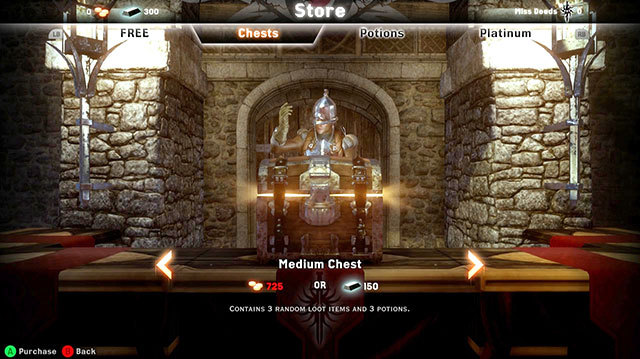
The dungeons are built with the three tile sets and one of three random enemy types inside. There's either demons, Venatori, or Red Templar guarding each instance, all three with their own unique enemies and attacks. It creates a situation where, although you're running through a Chateau endlessly, you're never running through the same Chateau. It gets a ton of mileage through the various tile sets and keeps things fresh even if you've just died in the Tevinter Ruins for the sixtieth time, knowing that this next run will be the one you'll actually finish.
The game itself is just fine. It's a solid way to spend 20 or so minutes with a few friends, wandering through castles, crafting gear, and trying not to be devoured by teleporting demons. It's a dungeon crawl through and through, and while it might take a bit to unlock different classes (via crafting), it's got enough solid hooks to keep you coming back again and again.
I won't lie, I'm a bit surprised about this whole thing in general. The entire time I was playing, I wondered why this was included in Inquisition at all. With no hooks linking it to the single player campaign at all, it's almost like I had two separate games that were, in a weird way, distracting me from one another. There were times I thought "I could be playing the campaign right now," while playing multi, and there were times when I'd be playing the campaign and wondering what sort of sick backflips my archer could be doing. After the reaction from Mass Effect 3's multiplayer affecting the single, I guess it was Bioware's best option to keep both games in entirely separate rooms refusing to acknowledge each other. Which is kind of a shame, really.
Back in September of 2012, the then President of EA Labels, Frank Gibeau, announced EA wasn't planning to make single player only games anymore, even with traditionally single player experiences. I suspect that Mr. Gibeau noticed the colossal amount of scrilla free-to-play products rake in on a regular basis and decided they needed to be in on that.

That being said, the real money currency in DA:I is kind of obfuscated. It's there, but by no means are they at all hitting you in the face with ads to buy Platinum. The only way you'd know the stuff exists is by checking out the tab in the in-game store. Everything can be purchased through currency earned in missions, while Platinum just expedites the process. It's kind of weird to call not being beaten over the head with microtransactions a "cool feature," but it's definitely great to see an almost passe attitude to it. "I mean, I guess you can spend your hard-earned real money, if you really want," the Quartermaster seems to say, poised over a large chest packed to the point of bursting with loot and potions. "But, like... You could just, ya know, play the game instead...."
Maybe EA is trying desperately to not sweep the "Worst Company in America" awards again. Maybe they've remembered they were a video game company and not a microtransation money-laundering front. Maybe a super generous parasite infected all the execs and their now hive-mentality concluded that money wasn't as important as customer satisfaction. There is no reason why this thing shouldn't be a $15 downloadable add on. But giving it to the players, free of charge on top of the already fully fleshed out single player campaign?
Well played, EA. You're not in the clear just yet, but keep this sort of stuff up and people might stop using your name in place of profanity.
Verdict
Co-Op Score
Overall
The Co-Op Experience: Dragon Age multiplayer is an action-packed dungeon-crawling four-player co-op experience that lets gamers play with their friends for the first time in the Dragon Age franchise.
Co-Optimus game reviews focus on the cooperative experience of a game, our final score graphic represents this experience along with an average score for the game overall. For an explanation of our scores please check our Review Score Explanation Guide.